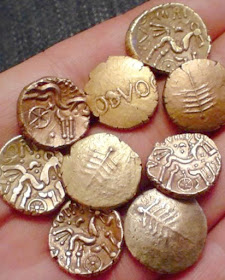 |
| A selection of Dobunni gold staters found by Dean Crawford over the years. photo: Dean Crawford |
"I went in to the archaeology department one day and added all the Roman-British sites I had discovered, adding useful information such as notable finds and dated the sites as per the finds.
"I recorded seventy two rural sites, of which forty seven were unknown. It turned out later that there were some aerial photographs of crop-marks of a couple of them but that was all.
"They were so impressed that I began metal detecting surveys on various projects and with great success. They paid me too. I still have the records of the projects and the finds. I also started working for other archaeology units around the country.
"The metal finds are interesting when compared to other tribes. Dobunni metal producing sites are far rarer to find. I have detected all over this country and the pattern is slightly different here in Dobunni land: for starters, the coins are harder to find due to the alloys on the majority of the later coins. Also it is rarer to find them on Roman sites for some reason. I must have found and detected on hundreds of rural Roman sites around here and probably less than ten of them produce Dobunni finds. Whereas, elsewhere in the country, you have a very good chance of finding the local Iron Age coins on a Roman site (Durotriges being the most prolific). Is this just due to the amount of coinage minted for each area? I'm not sure."
Dean Crawford (email correspondence).
The closest parallel to Dean, that I can find is farmer/numismatist/environmentalist Henry R. Mossop:
"On 6th November 1991, Glendining's, London sold the "H. R. Mossop collection, Celtic Coins of Britain and other English Hammered Coins". The sale was held on the third anniversary of Henry Mossop's death. Henry Richard Mossop is best known for his book The Lincoln Mint: c. 890-1279.37 After its publication, Mossop devoted his attention to the collection and study of Celtic coins. He corresponded with the two most eminent Celtic numismatists of the day, Derek F. Allen and Commander R. P. Mack and entered into a long working relationship with the archaeologist Jeffrey May. May had been a student of the great Christopher Hawkes and it was Hawkes who had recommended May to Nottingham University. Jeffrey May became the Head of Archaeology at Nottingham, publishing Prehistoric Lincolnshire, and the two volume Dragonby Report. In a 20th March 1989 letter to the independent scholar John Hooker, Jeffrey May said "I have been working on the coins of the Corieltauvi (formerly Coritani) for the last ten years or more, in collaboration with Mr. Henry Mossop, with a view to publishing an updated version of D. F. Allen's important book, Coins of the Coritani."There has been an enormous increase in the number of coins recorded since 1963; the progress of the work has been inevitably slow, and complicated by the death of Henry Mossop. Publication is still some way off, but I will let you know when it appears." Sadly, Jeffrey May passed away on July 15, 2006, aged 69. The work remains unfinished and unpublished.
You will not find a more detailed biography of Henry R. Mossop on the web. Archaeologist Ian Stead, Reading the Past: Current approaches to interpretation in archaeology, 1986, p.163 explains:"The increased numbers of Corieltauvian coins is due both to the start of the Celtic Coin Index and to the popularity of metal detecting in England. Henry Mossop was one of England's first environmentalists – planting thousands of trees on the family farm and he was a pioneer in metal detecting, importing one of the first machines from the U.S. He instructed other metal detectorists to record find details and the vast majority of the coins in his collection had the find spot recorded on the ticket. Always willing to share his collection with others he had many numismatist and archaeologist visitors to his farm and being of such a generous nature, he always insisted on filling their cars with fuel from his storage tank, saying, "After all, you've driven so far to come to see me". Mossop and May, together with D. F. Allen and Commander Mack built upon and expanded the earlier research into British Celtic coins started by the 19th century collector Sir John Evans—who became president of the Society of Antiquaries, president of what became the Royal Numismatic Society, and a Trustee of the BM. Seventy-four coins from Henry Mossop's collection are now at the British Museum.". Newcastle Paper, Ancient Coin Collectors Guild, p12f (with footnote references)
"Most individuals in the general public find it extremely difficult to develop their ideas about an alternative past in relation to the data from the past. They are excited by Von Daniken and films such as One Million Years B.C. and Raiders of the Lost Ark, and they develop their personal views about what the past must have been like, but they are kept at a distance from archaeological artefacts by glass cases, systems analyses and the jargon of social theory. When they do manage to gain some access to an immediately experienced past, they are often directly confronted by the archaeological establishment, or else their views are studiously ignored." (my Italics).Tomorrow, how archaeologist and bureaucratic mismanagement wasted all that Dean had to offer.
John's Coydog Community page
No comments:
Post a Comment